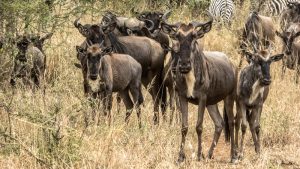A guide to the great migration in Tanzania
Yes, this is the dramatic time of the river crossing, when an uncountable onslaught of wildlife enters the Maasai Mara But the incredible scene playing out before you is but a slice of this yearly trek of grazers as they form a never-ending great circle route through Kenya and Tanzania. A guide to the great migration in Tanzania
Throughout the year, these hordes of grazers instinctively search out taller grasses, leading them through the different ecosystems. Each step of the way they must negotiate dangerous river crossings and lethal predators like the big cats who also instinctively are alert to these masses, lying in wait. Each group competes for sustenance along this 1000 km/620 mi trail of survival.
If you missed The Great Migration in Kenya’s Masai Mara, there are many opportunities to witness the numbers, the excitement, and the wonder of this mass event in Tanzania. It’s just a matter of knowing how to match your journey to the route of the animals.
The Birthing Season
The peak season of the migration in the Masai Mara is usually from June through October, but come November, the short rains begin and the masses of wildlife turn south, again crossing the Mara River, headed for the eastern flanks of Tanzania’s Serengeti and the Ngorongoro Conservation Area.
The Ngorongoro is the world’s largest intact volcanic caldera, and after the rains, the rich volcanic soil is verdant with thick, nutrition-rich grasses. Again, instincts are triggered attracting tens of thousands of wildebeest mothers, who flock here to drop, gestate, and nurture their newborns.

From Winter On Toward Spring
If you safari to this area of Tanzania during the birthing season, you’ll be treated to the wonder of over half a million wildlife babies – baying, crying, stumbling to nurse, to stand, and to become part of their herd.
Should you travel to these fertile fields later in the Spring, settle in to watch the hundreds of thousands of youngsters join their elders and begin their eternal march anew. Their instincts heightened by the distant storms, they can sense fresh grasses to the west and north.
By May, the immense lines of migration have formed stretching for miles as the mating season begins with the males engaging in fierce head-to-to head contests for dominance.
This is a grand display of another kind and we can show you the many aspects of this yearly Great Migration, from the Masai Mara to the Serengeti and beyond.
You get to pick and choose which or all of the stages of this incredible movement of wildlife you would like to witness. And we will bring you there. A guide to the great migration in Tanzania




